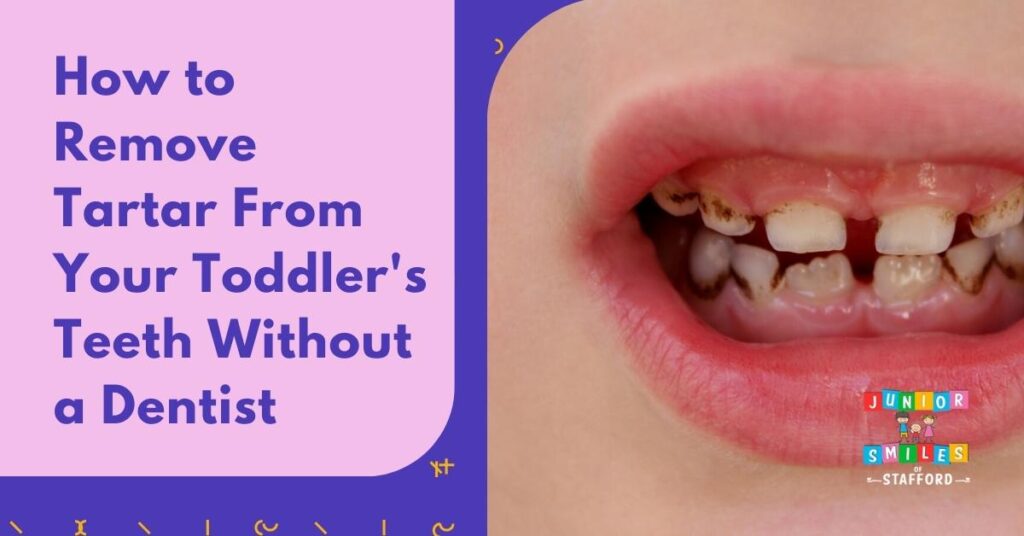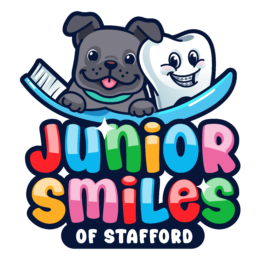How to Remove Tartar From Your Toddler’s Teeth Without a Dentist

When it comes to your child’s gums, have you observed a yellow or brownish material developing? Despite your best efforts, it just won’t go away with a simple brushing. Otherwise, they may be suffering from tartar buildup.
Plaque allowed to accumulate and calcify on the teeth becomes tartar (also known as dental calculus). Tartar not only stains teeth, but it may also pose long-term harm to the gums and teeth.
Using fluoride toothpaste and brushing your teeth twice a day is the most excellent approach to keep plaque and tartar from forming on your teeth. Bacteria can be kept at bay in hard-to-reach places by regular flossing and the use of an antiseptic mouthwash. Gargling with vinegar and water or brushing with baking soda might also help.
Plaque and tartar may be removed and prevented without the assistance of a dentist using the information provided here.
What is Tartar?
Tartar is a dental plaque buildup on the teeth. It is composed of bacteria, mucus, and food debris. If plaque is not removed regularly by brushing and flossing, it will mineralize into tartar. Tartar can cause tooth decay and gum disease.
Tartar builds up on teeth’s backs and fronts and in the spaces between them. Your teeth will become unsightly if you eat or drink anything that might stain this porous material.
Yellow or brown in color, hard and crusty in texture, tartar can grow either above or below the gum line (subgingival calculus). It cannot be removed with a toothbrush due to how tightly it adheres to children’s teeth.
Signs of Tartar Buildup and Its Effect on Oral Health
The way your teeth feel, you’ll probably be able to tell if you have tartar accumulation. Brushing alone cannot remove tartar buildup on your teeth. It might be brown, yellow, or tan, depending on the color of the tartar that has formed above the gum line.
Tartar that accumulates below the gum line can be black or brown, contributing to gum disease, bone loss, receding gums, and tooth loss. Other symptoms of periodontal disease include chronic foul breath, gum disease, cavities, gingivitis, tooth sensitivity, and bleeding and inflamed gums.
Tartar, if left untreated, can develop into a host of severe health problems. According to a report from the Department of Health and Human Services, stroke, heart disease, and diabetes risk can all be attributed to gum disease caused by tartar formation.
Removing Tartar At Home
Your child’s oral health is in jeopardy if you don’t keep plaque and tartar under control. There are several ways to remove tartar at home, but seeing a dentist is the most effective. Though here are some ways you can withdraw your child’s tartar at home:
Flossing
You can’t brush your teeth and gums to their fullest extent with a toothbrush. Thus, flossing is critical for removing plaque and food particles stuck between your teeth in hard-to-reach places. Keep in mind that preventing tartar growth on your teeth starts with keeping your teeth clean and free of germs.
Use a tartar-control toothpaste.
The use of a tartar-control toothpaste is recommended for the efficient removal of calculus from teeth. Fluoride and pyrophosphates in this toothpaste help to destroy plaque-causing bacteria and keep calcium phosphate deposits in the form of tartar at bay.
Brush twice daily
The best way to keep your teeth in good shape is to brush them twice a day, once in the morning and once at night. Even while this isn’t enough to eliminate tartar from your teeth, it is quite efficient in maintaining oral hygiene and avoiding tartar growth. In addition, an electric toothbrush may help loosen and eliminate tartar from your teeth more effectively.
Homemade remedies
You can use natural or homemade remedies such as white vinegar, glycerine, aloe vera, baking soda, orange peels, sesame seeds, or eating spicy foods.
Removing Tartar From Kids’ Teeth
Scaling is a process used by pediatric dentists to remove tartar and plaque from teeth. Dentists use a scaler to remove tartar from the teeth and below the gumline during a scaling procedure (sometimes termed a polishing procedure). A sophisticated electric scaler may be utilized if the tartar accumulation is significant.
Pediatric dentists remove tartar and then polish your child’s teeth to avoid future plaque buildup. A gritty paste is placed on your child’s teeth to smooth their surfaces during a painless treatment called tooth polishing. As a bonus, tooth polishing eliminates light stains from the surface of the teeth. Make sure to visit your child’s dentist regularly to achieve clean, healthy, and tartar-free teeth.
Preventing Tartar and Plaque Buildup
The most remarkable approach to prevent tartar and plaque from building up is with the right dental hygiene routine, as above, as well as regular visits to the dentist. But food also plays a key factor in keeping tartar and plaque at bay. Plaque can be prevented by reducing your intake of starchy and sugary foods. Bacteria in the mouth love sugary and starchy foods, and when that bacteria feeds on these foods, it generates the typical fuzzy teeth feeling known as plaque.
Limiting your intake of the following meals or cleaning your teeth afterward can help prevent plaque from forming.
- Candy
- Ice-cream
- Cakes and pies
- Dehydrated food sources
- Chips made of potatoes
- Flaky bread
Parents’ FAQs on Tartar
Is it painful to remove tartar on kids’ teeth?
No, not in most cases. Most children with tartar have just a little amount of tartar buildup, making the scaling treatment a quick and painless operation.
Is plaque harmful?
Children’s mouths become infested with microorganisms every time they ingest sweets. Bacteria multiply and grow in numbers. Plaque is formed as a result of this. Plaque is a collection of microorganisms that covers the teeth. As a result of its acid excretion, the tooth’s enamel is corroded. Plaque can lead to gingivitis, periodontitis, and a black smudge on the gumline.
Is it normal for toddlers to have tartar on their teeth?
It is completely normal. A child’s teeth can’t be free of plaque, according to a pediatric dentist. In the mouth, everyone is infected with microorganisms. The food particles in the mouth are constantly a source of nourishment for these creatures. Plaque is common in both children and adults. Plaque must be removed from the teeth on a regular basis by brushing and flossing correctly.
Read more: How to Clean Your Baby’s Tongue
Contact Junior Smiles of Stafford to learn more about tartar and its impact on your child’s dental health
Tartar is a serious dental health concern that can cause cavities, gum disease, and even tooth loss. If you’re concerned about tartar build-up on your child’s teeth, be sure to contact a reputable pediatric dentist like Junior Smiles of Stafford for a consultation. Our team of experts will be happy to answer any questions you have and help get your child’s smile back on track!
Why Choose Junior Smiles of Stafford?
Our Stafford, VA team is well-versed in working with clients of various ages and backgrounds. They’ll take the time to get to know you and your family’s requirements, and they’ll work with you to design a treatment plan that suits your schedule. Sealants and fluoride treatments are just two of the many preventative care options we provide to keep your mouth healthy.
About Us
Visiting Junior Smiles of Stafford means you’re in good hands when it comes to receiving high-quality care. Your child’s dental health improves with each visit, ensuring a brighter smile for years to come. We adhere to the ADA and AAPD’s guidelines for best practices.
Where Are We Located?
Phone: (540) 699-2441
Fax: (540) 699-2464
Email: info@juniorsmilesofstafford.com
Monday and Tuesday: 9:00 AM – 5:00 PM
Wednesdays and Thursdays: 8:00 AM – 4:00 PM
Fridays and Saturdays: 9:00 AM – 2:00 PM (By appointment only)
How to Book Your Kids First Appointment at Junior Smiles of Stafford
Fill out the form on our website. Within 24 hours, a member of our team will get back to you.

